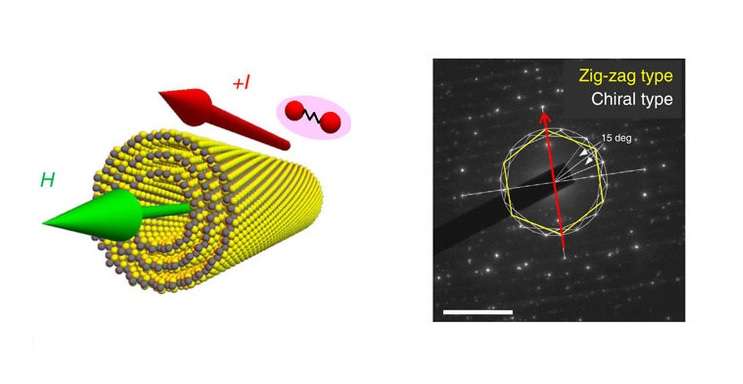February 27, 2017 feature
Chiral superconductivity experimentally demonstrated for the first time

(Phys.org)—Scientists have found that a superconducting current flows in only one direction through a chiral nanotube, marking the first observation of the effects of chirality on superconductivity. Until now, superconductivity has only been demonstrated in achiral materials, in which the current flows in both directions equally.
The team of researchers, F. Qin et al., from Japan, the US, and Israel, have published a paper on the first observation of chiral superconductivity in a recent issue of Nature Communications.
Chiral superconductivity combines two typically unrelated concepts in a single material: Chiral materials have mirror images that are not identical, similar to how left and right hands are not identical because they cannot be superimposed one on top of the other. And superconducting materials can conduct an electric current with zero resistance at very low temperatures.
Observing chiral superconductivity has been experimentally challenging due to the material requirements. Although carbon nanotubes are superconducting, chiral, and commonly available, so far researchers have only successfully demonstrated superconducting electron transport in nanotube assemblies and not in individual nanotubes, which are required for this purpose.
"The most important significance of our work is that superconductivity is realized in an individual nanotube for the first time," coauthor Toshiya Ideue at The University of Tokyo told Phys.org. "It enables us to search for exotic superconducting properties originating from the characteristic (tubular or chiral) structure."
The achievement is only possible with a new two-dimensional superconducting material called tungsten disulfide, a type of transition metal dichalcogenide, which is a new class of materials that have potential applications in electronics, photonics, and other areas. The tungsten disulfide nanotubes are superconducting at low temperatures using a method called ionic liquid gating and also have a chiral structure. In addition, it's possible to run a superconducting current through an individual tungsten disulfide nanotube.
When the researchers ran a current through one of these nanotubes and cooled the device down to 5.8 K, the current became superconducting—in this case, meaning its normal resistance dropped by half. When the researchers applied a magnetic field parallel to the nanotube, they observed small antisymmetric signals that travel in one direction only. These signals are negligibly small in nonchiral superconducting materials, and the researchers explain that the chiral structure is responsible for strongly enhancing these signals.
"The asymmetric electric transport is realized only when a magnetic field is applied parallel to the tube axis," Ideue said. "If there is no magnetic field, current should flow symmetrically. We note that electric current should be asymmetric (if the magnetic field is applied parallel to the tube axis) even in the normal state (non-superconducting region), but we could not see any discernible signals in the normal state yet, interestingly, it shows a large enhancement in the superconducting region."
Currently, the researchers aren't exactly sure what causes the asymmetric electric transport in the chiral superconducting nanotubes. They plan to further investigate these mechanisms in the future, which would reveal new insight into the relationship between superconductivity and chirality.
"Our next plan is to understand the microscopic mechanism of the observed phenomena," Ideue said. "In addition, we will try to verify the universality of the nonreciprocal superconducting transport and its enhancement in the superconducting region."
Although it may be too early to tell what kinds of applications chiral superconductivity might have, the researchers explain that the one-way effect shares similarities with existing technologies.
"One thing we can say is that nonreciprocal electric transport can be understood as a 'rectification effect' or 'diode-like functionality' (if it is large) so that it might be used to realize a 'superconducting diode' which could have potential applications for superconducting circuits," Ideue said.
More information: "Superconductivity in a chiral nanotube." Nature Communications. DOI: 10.1038/ncomms14465
Abstract
Chirality of materials are known to affect optical, magnetic and electric properties, causing a variety of nontrivial phenomena such as circular dichiroism for chiral molecules, magnetic Skyrmions in chiral magnets and nonreciprocal carrier transport in chiral conductors. On the other hand, effect of chirality on superconducting transport has not been known. Here we report the nonreciprocity of superconductivity—unambiguous evidence of superconductivity reflecting chiral structure in which the forward and backward supercurrent flows are not equivalent because of inversion symmetry breaking. Such superconductivity is realized via ionic gating in individual chiral nanotubes of tungsten disulfide. The nonreciprocal signal is significantly enhanced in the superconducting state, being associated with unprecedented quantum Little-Parks oscillations originating from the interference of supercurrent along the circumference of the nanotube. The present results indicate that the nonreciprocity is a viable approach toward the superconductors with chiral or noncentrosymmetric structures.
Journal information: Nature Communications
© 2017 Phys.org




















